FIAT QUBO 2010 1.G Owner's Guide
Manufacturer: FIAT, Model Year: 2010, Model line: QUBO, Model: FIAT QUBO 2010 1.GPages: 230, PDF Size: 4.38 MB
Page 31 of 230
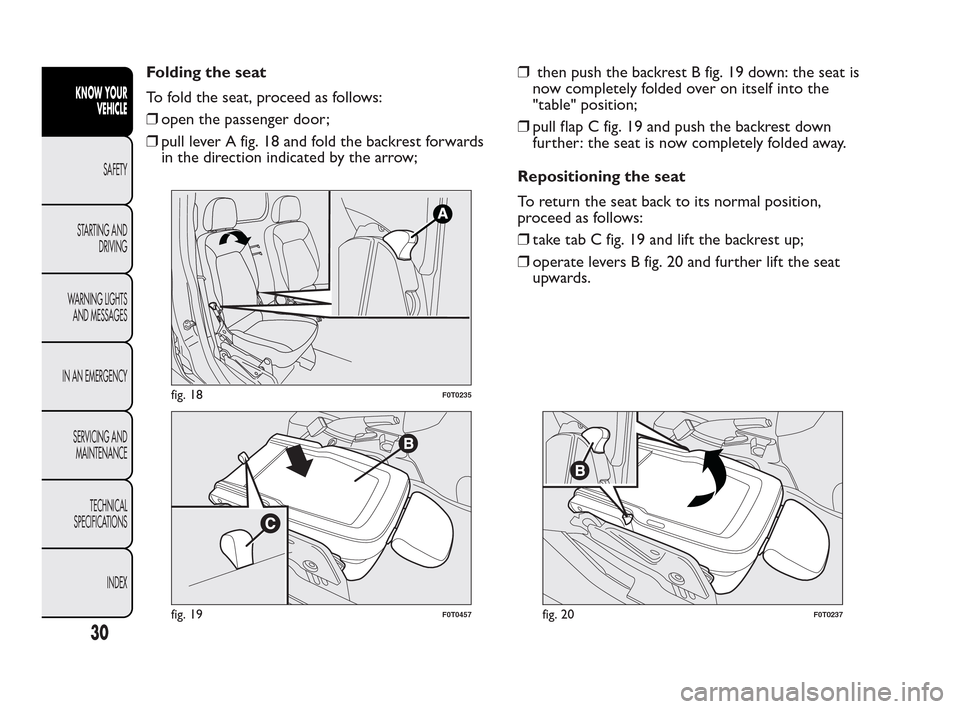
Folding the seat
To fold the seat, proceed as follows:
❒open the passenger door;
❒pull lever A fig. 18 and fold the backrest forwards
in the direction indicated by the arrow;❒then push the backrest B fig. 19 down: the seat is
now completely folded over on itself into the
"table" position;
❒pull flap C fig. 19 and push the backrest down
further: the seat is now completely folded away.
Repositioning the seat
To return the seat back to its normal position,
proceed as follows:
❒take tab C fig. 19 and lift the backrest up;
❒operate levers B fig. 20 and further lift the seat
upwards.
fig. 18F0T0235
fig. 19F0T0457fig. 20F0T0237
30
KNOW YOUR
VEHICLE
SAFETY
ST
ARTING AND
DRIVING
WARNING LIGHTS
AND MESSAGES
IN AN EMERGENCY
SERVICING AND
MAINTENANCE
TECHNICAL
SPECIFICATIONS
INDEX
Page 32 of 230
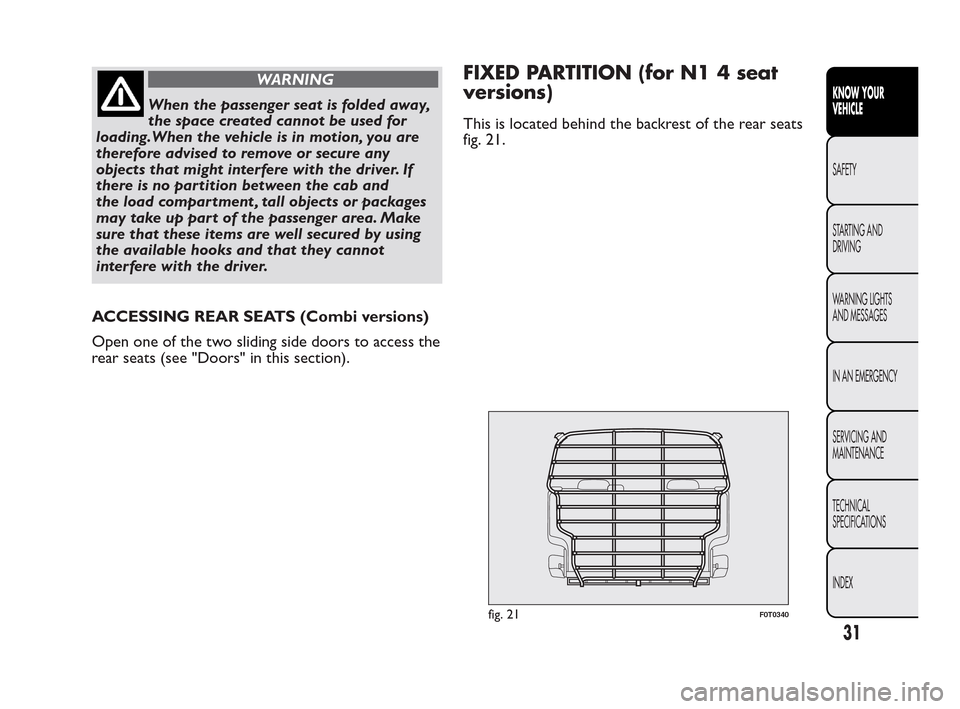
WARNING
When the passenger seat is folded away,
t
he space created cannot be used for
loading.When the vehicle is in motion, you are
therefore advised to remove or secure any
objects that might interfere with the driver. If
there is no partition between the cab and
the load compartment , tall objects or packages
may take up part of the passenger area. Make
sure that these items are well secured by using
the available hooks and that they cannot
interfere with the driver.
ACCESSING REAR SEATS (Combi versions)
Open one of the two sliding side doors to access the
rear seats (see "Doors" in this section).
FIXED PARTITION (for N1 4 seat
versions)
This is located behind the backrest of the rear seats
fig. 21.
fig. 21F0T0340
31
KNOW YOUR
VEHICLE
SAFETY
ST
ARTING AND
DRIVING
WARNING LIGHTS
AND MESSAGES
IN AN EMERGENCY
SERVICING AND
MAINTENANCE
TECHNICAL
SPECIFICATIONS
INDEX
Page 33 of 230
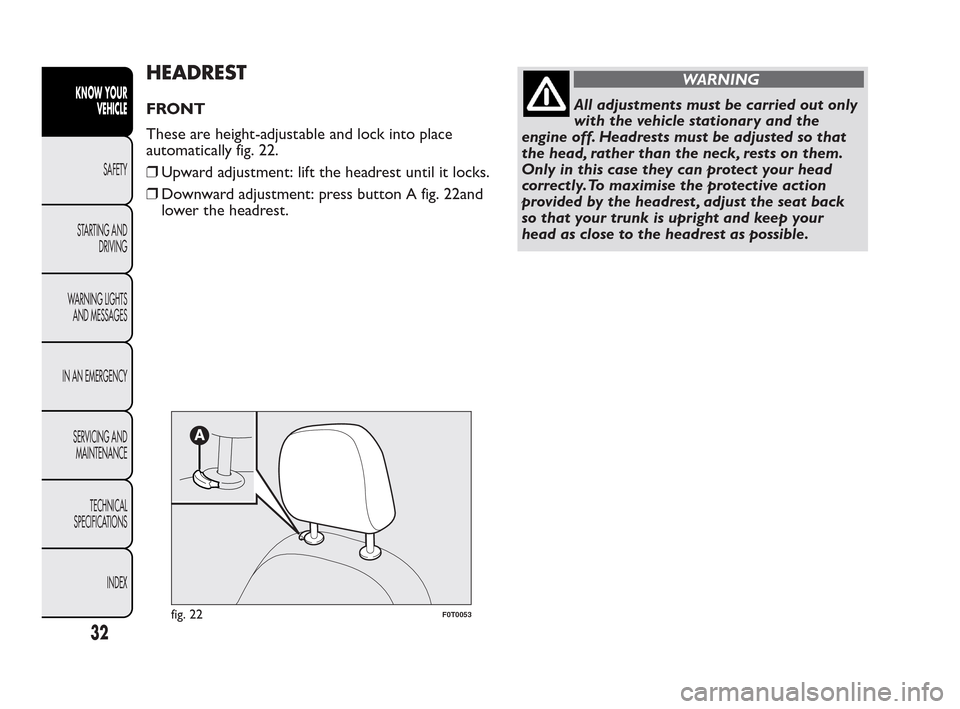
HEADREST
FRONT
These are height-adjustable and lock into place
automatically fig. 22.
❒Upward adjustment: lift the headrest until it locks.
❒Downward adjustment: press button A fig. 22and
lower the headrest.
WARNING
All adjustments must be carried out only
wi
th the vehicle stationary and the
engine off. Headrests must be adjusted so that
the head, rather than the neck, rests on them.
Only in this case they can protect your head
correctly.To maximise the protective action
provided by the headrest , adjust the seat back
so that your trunk is upright and keep your
head as close to the headrest as possible.
fig. 22F0T0053
32
KNOW YOUR
VEHICLE
SAFETY
ST
ARTING AND
DRIVING
WARNING LIGHTS
AND MESSAGES
IN AN EMERGENCY
SERVICING AND
MAINTENANCE
TECHNICAL
SPECIFICATIONS
INDEX
Page 34 of 230

REAR
(for versions/markets, where provided)
Lift up to use.
To put the headrests away, press buttons A fig. 23 fig.
24 and push them down into the backrest.To extract the headrests, raise them until you hear
the click (which indicates they are in "all extracted"
position).
IMPORTANT The headrests must always be in the
"all extracted" position when the rear seats are
in use.
fig. 23F0T0054
fig. 24 - N1 versions (4 seats)F0T0341
33
KNOW YOUR
VEHICLE
SAFETY
ST
ARTING AND
DRIVING
WARNING LIGHTS
AND MESSAGES
IN AN EMERGENCY
SERVICING AND
MAINTENANCE
TECHNICAL
SPECIFICATIONS
INDEX
Page 35 of 230
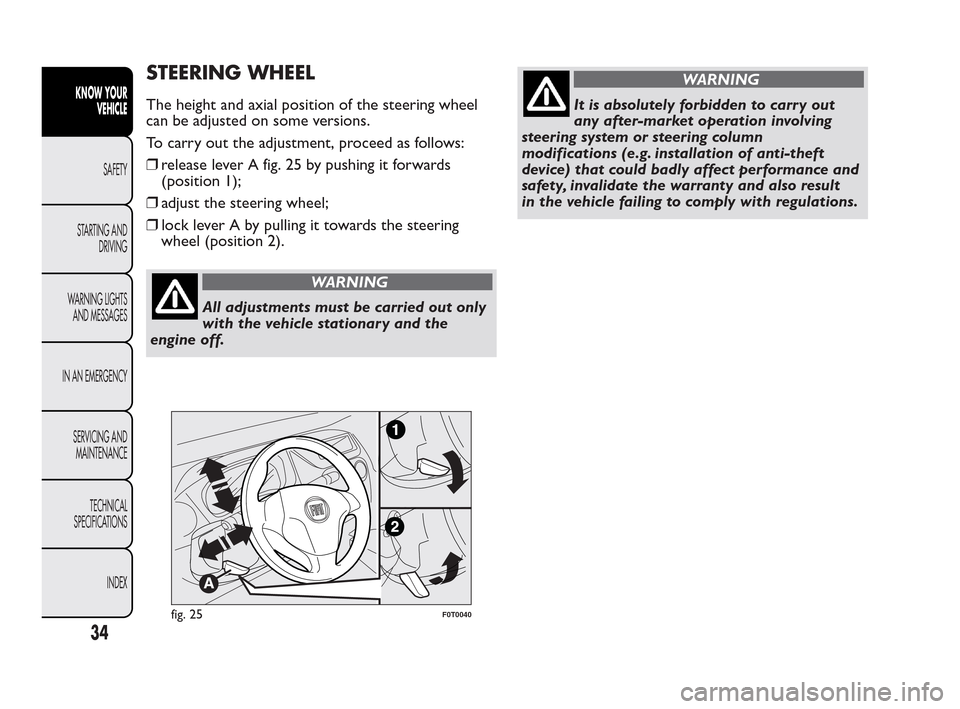
STEERING WHEEL
The height and axial position of the steering wheel
can be adjusted on some versions.
To carry out the adjustment, proceed as follows:
❒release lever A fig. 25 by pushing it forwards
(position 1);
❒adjust the steering wheel;
❒lock lever A by pulling it towards the steering
wheel (position 2).
WARNING
All adjustments must be carried out only
wi
th the vehicle stationary and the
engine off.
WARNING
It is absolutely forbidden to carry out
an
y after-market operation involving
steering system or steering column
modifications (e.g. installation of anti-theft
device) that could badly affect performance and
safety, invalidate the warranty and also result
in the vehicle failing to comply with regulations.
fig. 25F0T0040
34
KNOW YOUR
VEHICLE
SAFETY
ST
ARTING AND
DRIVING
WARNING LIGHTS
AND MESSAGES
IN AN EMERGENCY
SERVICING AND
MAINTENANCE
TECHNICAL
SPECIFICATIONS
INDEX
Page 36 of 230
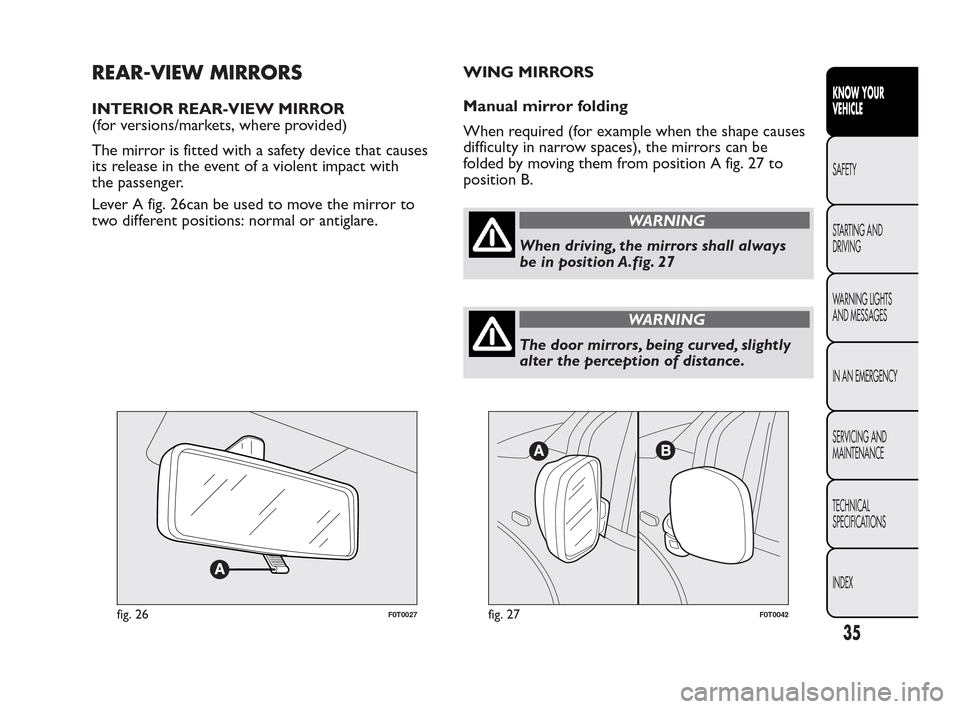
REAR-VIEW MIRRORS
INTERIOR REAR-VIEW MIRROR
(for versions/markets, where provided)
The mirror is fitted with a safety device that causes
its release in the event of a violent impact with
the passenger.
Lever A fig. 26can be used to move the mirror to
two different positions: normal or antiglare.WING MIRRORS
Manual mirror folding
When required (for example when the shape causes
difficulty in narrow spaces), the mirrors can be
folded by moving them from position A fig. 27 to
position B.
WARNING
When driving, the mirrors shall always
be
in position A.fig. 27
WARNING
The door mirrors, being curved, slightly
al
ter the perception of distance.
fig. 26F0T0027fig. 27F0T0042
35
KNOW YOUR
VEHICLE
SAFETY
ST
ARTING AND
DRIVING
WARNING LIGHTS
AND MESSAGES
IN AN EMERGENCY
SERVICING AND
MAINTENANCE
TECHNICAL
SPECIFICATIONS
INDEX
Page 37 of 230
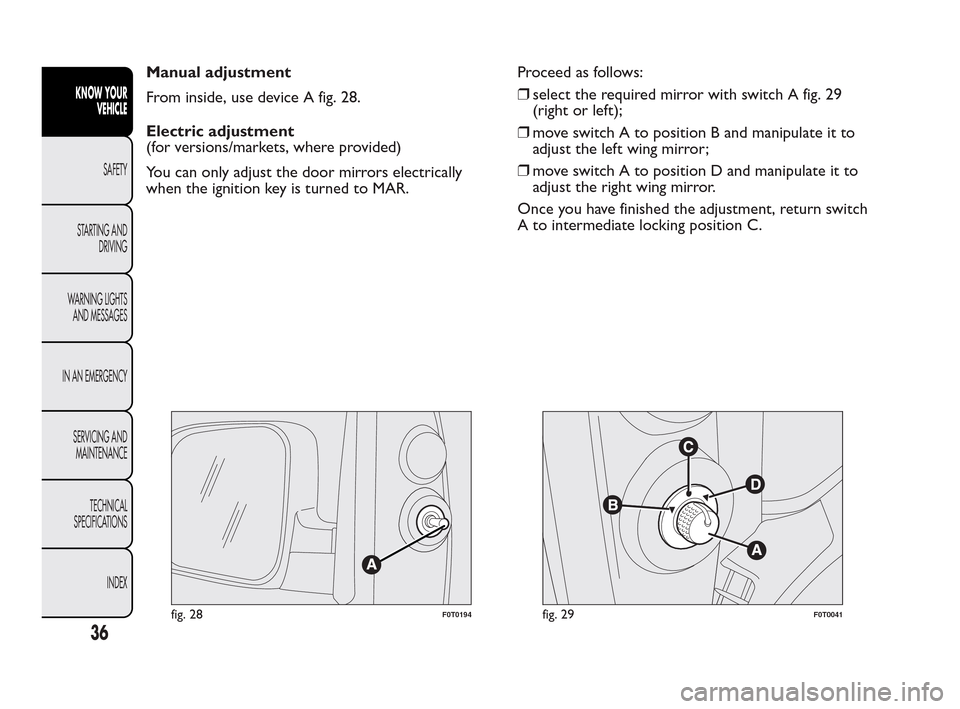
Manual adjustment
From inside, use device A fig. 28.
Electric adjustment
(for versions/markets, where provided)
You can only adjust the door mirrors electrically
when the ignition key is turned to MAR.Proceed as follows:
❒select the required mirror with switch A fig. 29
(right or left);
❒move switch A to position B and manipulate it to
adjust the left wing mirror;
❒move switch A to position D and manipulate it to
adjust the right wing mirror.
Once you have finished the adjustment, return switch
A to intermediate locking position C.
fig. 28F0T0194fig. 29F0T0041
36
KNOW YOUR
VEHICLE
SAFETY
ST
ARTING AND
DRIVING
WARNING LIGHTS
AND MESSAGES
IN AN EMERGENCY
SERVICING AND
MAINTENANCE
TECHNICAL
SPECIFICATIONS
INDEX
Page 38 of 230
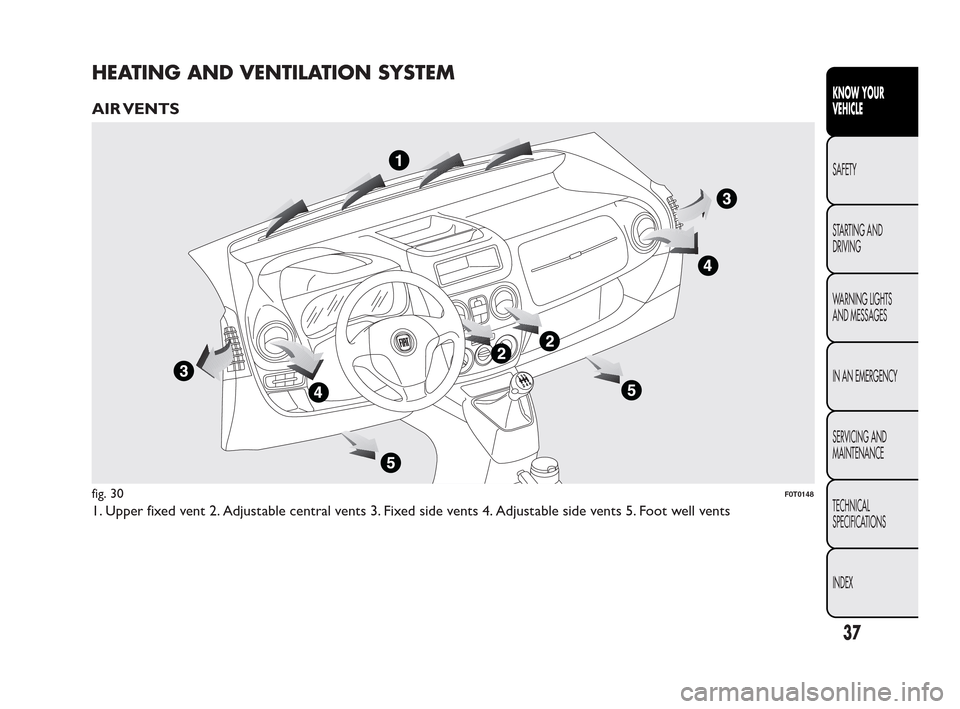
HEATING AND VENTILATION SYSTEM
AIR VENTS
1. Upper fixed vent 2. Adjustable central vents 3. Fixed side vents 4. Adjustable side vents 5. Foot well vents
fig. 30F0T0148
37
KNOW YOUR
VEHICLE
SAFETY
ST
ARTING AND
DRIVING
WARNING LIGHTS
AND MESSAGES
IN AN EMERGENCY
SERVICING AND
MAINTENANCE
TECHNICAL
SPECIFICATIONS
INDEX
Page 39 of 230
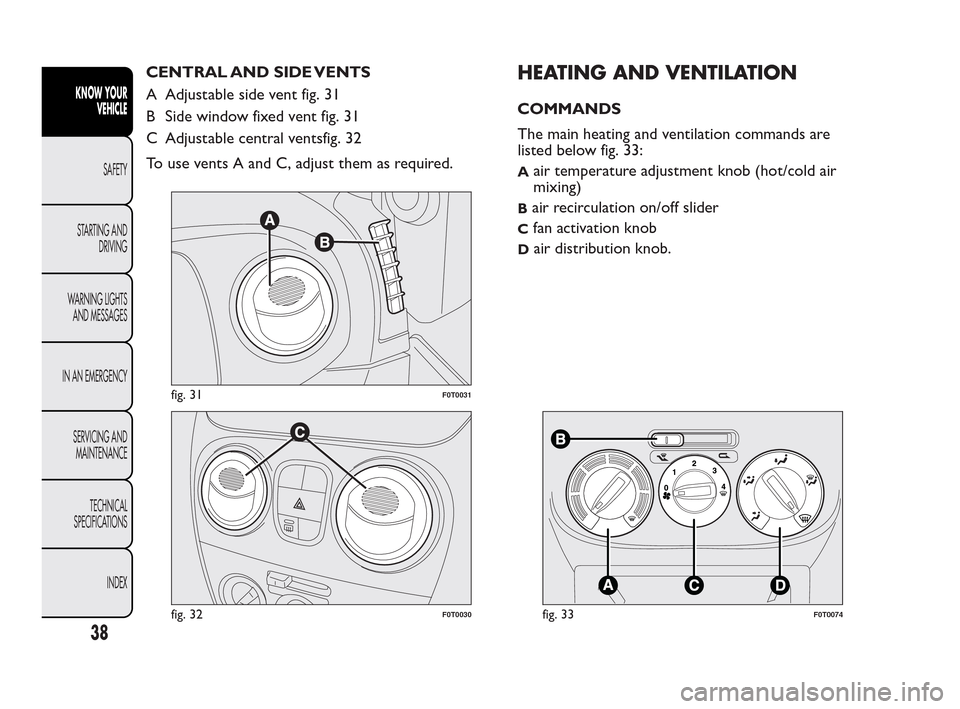
CENTRAL AND SIDE VENTS
A Adjustable side vent fig. 31
B Side window fixed vent fig. 31
C Adjustable central ventsfig. 32
To use vents A and C, adjust them as required.HEATING AND VENTILATION
COMMANDS
The main heating and ventilation commands are
listed below fig. 33:
Aair temperature adjustment knob (hot/cold air
mixing)
Bair recirculation on/off slider
Cfan activation knob
Dair distribution knob.
fig. 31F0T0031
fig. 32F0T0030fig. 33F0T0074
38
KNOW YOUR
VEHICLE
SAFETY
ST
ARTING AND
DRIVING
WARNING LIGHTS
AND MESSAGES
IN AN EMERGENCY
SERVICING AND
MAINTENANCE
TECHNICAL
SPECIFICATIONS
INDEX
Page 40 of 230
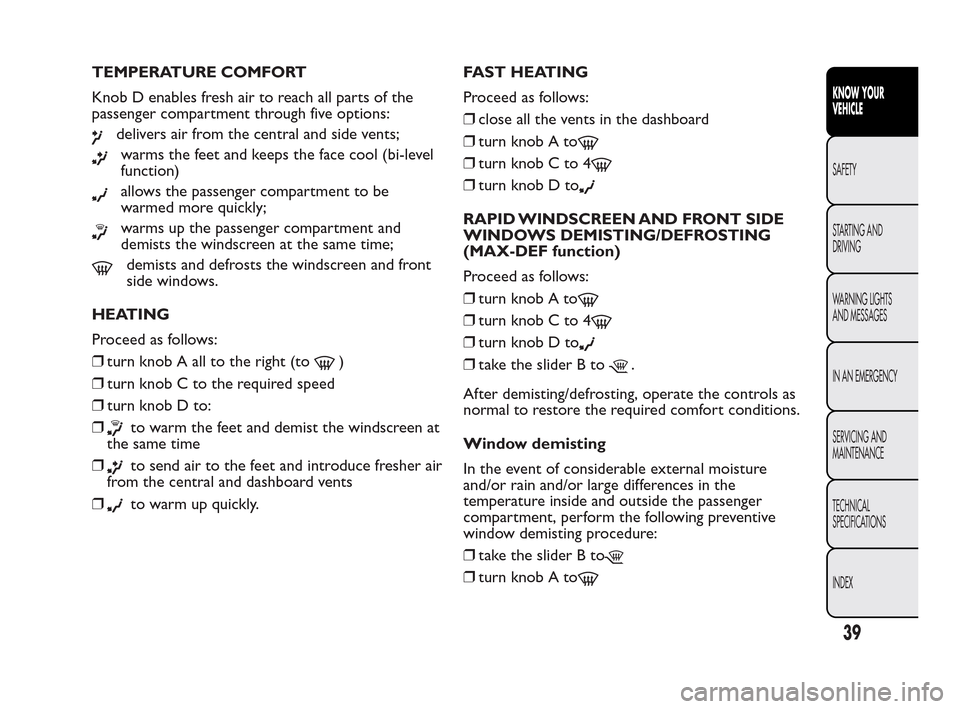
TEMPERATURE COMFORT
Knob D enables fresh air to reach all parts of the
passenger compartment through five options:
delivers air from the central and side vents;
warms the feet and keeps the face cool (bi-level
function)
allows the passenger compartment to be
warmed more quickly;
warms up the passenger compartment and
demists the windscreen at the same time;
demists and defrosts the windscreen and front
side windows.
HEATING
Proceed as follows:
❒turn knob A all to the right (to
)
❒turn knob C to the required speed
❒turn knob D to:
❒
to warm the feet and demist the windscreen at
the same time
❒
to send air to the feet and introduce fresher air
from the central and dashboard vents
❒
to warm up quickly.FAST HEATING
Proceed as follows:
❒close all the vents in the dashboard
❒turn knob A to
❒turn knob C to 4
❒turn knob D to
RAPID WINDSCREEN AND FRONT SIDE
WINDOWS DEMISTING/DEFROSTING
(MAX-DEF function)
Proceed as follows:
❒turn knob A to
❒turn knob C to 4
❒turn knob D to
❒take the slider B to.
After demisting/defrosting, operate the controls as
normal to restore the required comfort conditions.
Window demisting
In the event of considerable external moisture
and/or rain and/or large differences in the
temperature inside and outside the passenger
compartment, perform the following preventive
window demisting procedure:
❒take the slider B to
❒turn knob A to
39
KNOW YOUR
VEHICLE
SAFETY
ST
ARTING AND
DRIVING
WARNING LIGHTS
AND MESSAGES
IN AN EMERGENCY
SERVICING AND
MAINTENANCE
TECHNICAL
SPECIFICATIONS
INDEX